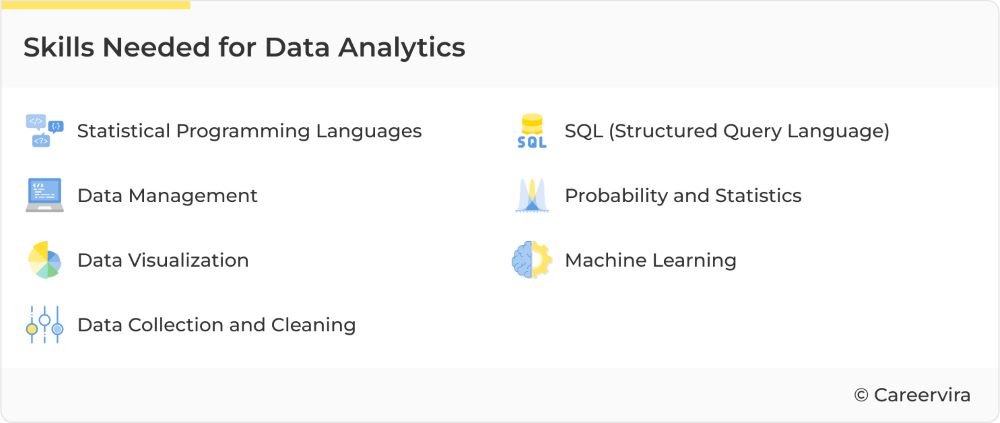An Introduction to Data Analytics
Companies are generating more data than we think; quoting LinkedIn, they are generating 2,000,000,000,000,000,000 bytes or 1818.99 terabytes every day! Talking about people, there were around 1.7 trillion photos clicked in 2022. This shows how much data is on the web and needs to be sorted. Here Data Analytics Professionals are needed to analyze this raw data and find useful information.
Fortune Business Insights reports, that the Data Analytics market is expected to grow from $271.83 billion to $655.53 billion from 2019-2029, at a CAGR (Compounded Annual Growth Rate) of 13.4% in the forecast period. Data Analytics analyzes and converts raw data into meaningful insights. It involves various technologies, tools and processes to solve problems and find trends using data. Businesses use Data Analytics to shape their process, increase their growth and improve decision-making. There has been a multifold advancement in the Data Analytics market, and to quote Precedence Research, it is predicted to grow at a CAGR of 30.41% from 2022 to 2030. It is expected to surpass around USD 346.33 billion by 2030.
If you are considering a career in Data Analytics, this blog is a great resource to read. In this blog, you will find all the must-have Data Analytics skills to get hired in this field and the best online Data Analytics courses that will be helpful.
Why Becoming a Data Analyst is a Good Career Choice?
Data Analytics is a growing field, and making a career here is a good choice. Here are some reasons to show why:
- High Demand: Data Analysts are not easy to find and thus have a high demand in the market; every industry needs to sort its data and grow its business; for that, Data Analysts are needed. There are various career opportunities for Data Analysts with a positive job outlook.
- High Salary: Data Analysts have high demand, and because of that, they are paid well too. They have a higher salary, and quoting Indeed, the average annual salary of a Data Analyst is around $73,000. They earn approximately 26% more than the national average salary in the United States (around $53,500 annually).
- Versatality: Almost every industry is trying to process raw data into useful information, and they need Data Analysts. This means they can pick from many industries as per their interests. You can work in industries like Media and Entertainment, Banks, Healthcare, Education, Manufacturing, etc.
- Varied Backgrounds: Usually, Data Analysts have a technical or analytical background, but with the appropriate skills, professionals from different backgrounds can also become Data Analysts. Professionals working in industries like Sales, Marketing, Information Technology (IT), and more have a good chance to make their career in the Data Analytics field.
- Creating the Future: Data Analytics is not just creating the future; it is the future too. Companies are collecting customer data and know its importance for their growth. Data Analysts love solving problems and providing appropriate solutions. They look for patterns, changes and trends in the raw data to help companies make informed decisions. This helps indicate a company’s performance.
Top Technical Skills Needed for Data Analytics
The Data Analytics field is technical, and you must have the following in-demand skills to become a successful Data Analyst:
- Statistical Programming Languages: Statistical Programming languages, like Python, R, etc., help you with advanced analysis, which isn’t possible in Excel. If you are proficient in these languages, you can also efficiently clean, analyze, and visualize large data sets. These open-source languages are easy to learn and helpful in the Data Analytics industry.
- SQL (Structured Query Language): SQL or Structured Query Language is the standard database communication language. It helps you update, organize, query data stored in relational databases, and modify data structures (schema).
- Data Management: Data Management is the collection, organization and storage of data in a secure, efficient and cost-effective way. Learning Data Management can help you better understand how databases work in physical and cloud environments.
- Probability and Statistics: Probability and Statistics are concerned with the collection, analysis, interpretation and presentation of data. It helps you identify trends and patterns in data, produce accurate results and avoid fallacies and logical errors in your analysis.
- Data Visualization: Data Visualization is to identify data findings through graphics or other illustrations. It offers a better understanding of data-driven insights. Data Analysts use this skill to identify patterns and understand complex ideas. This aids them in gaining a better understanding of a company’s situation and offers useful insights to team leaders.
- Machine Learning: Machine Learning (ML) is an important Data Analysis skill that helps computers automatically learn and perform tasks without explicit programming. Data Analysts must learn Machine Learning to create, apply, and train appropriate algorithms and models to datasets to find solutions for specific problems.
- Data Collection and Cleaning: Data Collection is the collection and management of data based on the variables related to the goal an organization wants to accomplish through analysis. Data Cleaning removes and fixes all the incorrect data in the dataset, including corrupted, duplicated and incorrectly formatted data. It ensures the accuracy of data.
Best Courses to Learn and Grow in the Data Analytics Field
Thanks to the skills required for Data Analytics, a professional can come from any background and still bag a job as a Data Analyst. Companies are looking for skillful employees who can help them make informed decisions and increase their growth. Many industries require Data Analysts and offer high salaries. Professionals must have the required skills to increase their chances of getting hired. You can gain those skills by pursuing online courses, and here are some of our best courses to help you:
- 3 Essential Excel Skills for Data Analysts by Simpliv: This course will teach you how to slice and dice your data to create impactful and useful information. It begins with discussing the key features of tables and learning several tips and tricks to manipulate them. It will teach you data manipulation and answer those questions that are necessary to answer for your business.
- Minitab Essentials Bootcamp by Simpliv: This Bootcamp course by Simpliv covers all the essentials of Minitab. It is one of the most in-demand statistical software in today’s corporate world and was designed for Six Sigma projects. This course aids professionals working in the organization’s quality improvement processes to reduce the duration of data analysis.
Career Prospects in Data Analytics
Before beginning a career in the Data Analytics field, here are some alternative careers with their average annual salaries.
Final Thoughts
You can enter any field with certain degrees, but your skills will help you grow. Polishing your skills is necessary when working as a Data Analyst. The Data Analytics field offers high-salaried jobs in multiple sectors like Banking, Healthcare, Education, and more. This is an ever-growing sector that is shaping the future.
Globe Newswire reports, that the Data Analytics market is expected to be valued at USD 346.24 Billion at a CAGR (Compound Annual Growth Rate) of 30.7% by 2030. Apart from Data Analyst, there are other good-paying jobs where these skills will be useful. You can pursue our online Data Analytics courses and polish your skills for Data Analytics to become a successful professional in this sector.





![Python Loops and Functions: Complete Guide [With Examples]](http://913593.niammsnz.asia/wp-content/uploads/2020/03/0-100x70.jpg)